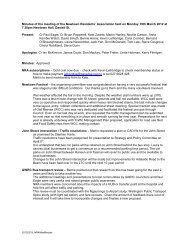Draft Town Belt Management Plan - Wellington City Council
Draft Town Belt Management Plan - Wellington City Council
Draft Town Belt Management Plan - Wellington City Council
You also want an ePaper? Increase the reach of your titles
YUMPU automatically turns print PDFs into web optimized ePapers that Google loves.
known by some as the kahui tipua, who moved around taking advantage of the natural resources of<br />
the region.<br />
Ngāi Tara built a series of pā, the largest being the Akatarewa Pā on the <strong>Town</strong> <strong>Belt</strong> around<br />
<strong>Wellington</strong> College and extending up to the ridgeline. The Basin Reserve was the mahinga kai<br />
(access to food and resources) called Hauwai, where the eels and other fish from the swamp<br />
streams were gathered.<br />
The other great ridgeline to frame <strong>Wellington</strong> <strong>City</strong> was known as Ahumairangi and later as<br />
Tinakori Hill. Ahumairangi was to feature more in later Māori history as a place where Te<br />
Atiawa/Taranaki Whānui were to establish gardens to feed the pā below and keep lookouts to warn<br />
of the approach of raiding parties from other tribes. The name Ahumairangi could have derived<br />
from a type of whirlwind. That ridgeline was less favoured for building pā and none were known to<br />
be located there. By the time of Te Atiawa/Taranaki Whānui there had been the change from<br />
fortified pā situated on defendable headlands to pā with minimal fortifications sited around the<br />
harbour and close to the foreshore.<br />
Not all the areas included in the <strong>Town</strong> <strong>Belt</strong> were occupied by Māori with pā and kainga, but the<br />
entire area would have been used for food gathering with birds being snared. This is acknowledged<br />
in names such as Paekaka, which probably referred to the tree perch for catching parrots and was<br />
the name of a village situated in Thorndon close to the <strong>Town</strong> <strong>Belt</strong>.<br />
Sites of significance to Māori are listed below. Those protected as “Sites of Significance to Tangata<br />
Whenua or other Maori” in the District <strong>Plan</strong> are noted.<br />
Tinakori and Orangikaupapa: 80 acres of the <strong>Town</strong> <strong>Belt</strong> were awarded by McCleverty to<br />
Pipitea Māori in 1847. It is known that the <strong>Town</strong> <strong>Belt</strong> contained Māori cultivations, although it is<br />
not known if they were on these lands awarded to Māori.<br />
Polhill Gully Moe-i-ra: The area known as Polhill Gully, as established in McCleverty’s Award,<br />
comprised 89 acres three roods and five perches. This included 31 town sections, mainly along Aro<br />
Street, as well as the <strong>Town</strong> <strong>Belt</strong> additions known as blocks XV, XVa and XVb. By 1873, the Te Aro<br />
Māori owners were leasing out the three big <strong>Town</strong> <strong>Belt</strong> blocks along with most of the town sections<br />
to settler farmers.<br />
Moera (M56 District <strong>Plan</strong>): Moe-ra (Moe-i-ra 22 or Moe-i-te-ra 23 ) was “a Ngāti Awa kainga,<br />
possibly pallisaded”. It was situated where Marama Crescent now is, near the road to Brooklyn and<br />
Ohiro.<br />
Omaroro cultivation area (M74 District <strong>Plan</strong>): was located on steeply sloping ground, which<br />
was perhaps terraced on a spur of the Turangarere hills at Brooklyn facing north-east within an<br />
area now part of the <strong>Town</strong> <strong>Belt</strong>. This area became the Vogeltown Block and was awarded to Wi<br />
Tako Ngatata of Kumutoto Pā.<br />
Kumutoto kainga (M66 District <strong>Plan</strong>): Cultivations were situated on what is now the Botanic<br />
Garden.<br />
Te Akatarewa Pā (M70 District <strong>Plan</strong>): (above the Mt Victoria tunnel) was formerly home of<br />
Ngāi Tara.<br />
Matairangi/Tangi-te-keo - Mt Victoria (M72 District <strong>Plan</strong>): Māori tradition has it that<br />
<strong>Wellington</strong> Harbour was occupied by two taniwha, Ngāke and Whataitai. In their time the harbour<br />
was a lake blocked from the ocean and Ngāke wanted to escape to the open ocean. He crashed out<br />
to form the channel known as Te Au a Tane, the present channel into <strong>Wellington</strong> harbour. When<br />
Whataitai tried to follow suit through the area where Kilbirnie now is, he failed and became<br />
22 Cited by Neville Gilmore, Historian for <strong>Wellington</strong> Tenths Trust.<br />
23 Adkin, G Leslie: The Great Harbour of Tara 1959, p42.<br />
56<br />
<strong>Draft</strong> <strong>Town</strong> <strong>Belt</strong> <strong>Management</strong> <strong>Plan</strong> October 2012





